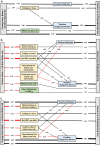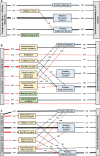Disparities in Breastfeeding Among U.S. Black Mothers: Identification of Mechanisms
- PMID: 33539248
- PMCID: PMC7891211
- DOI: 10.1089/bfm.2020.0310
Disparities in Breastfeeding Among U.S. Black Mothers: Identification of Mechanisms
Abstract
Objective: Disparities in U.S. breastfeeding rates persist among Black mothers according to birth country and between Black and White mothers, necessitating further investigation of modifiable mediating factors to inform interventions. This study seeks to examine the extent that social, maternal, infant factors and Theory of Planned Behavior (TPB) domains (attitudes, perceived control, and subjective norms) mediate the association of maternal race/birth country and breastfeeding continuation. Methods: A national cohort of 2,050 mothers self-identifying as U.S.-born non-Hispanic Black (n = 689), foreign-born non-Hispanic Black (n = 139), and U.S.-born non-Hispanic White (n = 1,222) was analyzed. Using logistic regression, associations of race/birth country and any/exclusive breastfeeding at 2-6 months were examined. Structural equation modeling was used to determine whether social, maternal, and infant factors and TPB domains mediate these relationships. Results: 40.0% of U.S.-born Black, 82.2% of foreign-born Black, and 57.3% of U.S.-born White mothers reported any breastfeeding at 2-6 months. Compared with U.S.-born Black mothers, odds of any breastfeeding were sevenfold higher among foreign-born Black mothers (odds ratio [OR] = 7.04 95% confidence interval [CI] = 4.80-10.31), which was explained partly by social/maternal/infant factors and TPB domains. Compared with U.S.-born White mothers, any breastfeeding was lower (OR = 0.54, 95% CI = 0.40-0.73) among U.S.-born Black mothers and higher (OR = 3.81, 95% CI = 2.48-5.87) among foreign-born Black mothers; these differences were also mediated by the aforementioned factors. Conclusions: Among Black mothers in the United States, breastfeeding continuation varied substantially by birth country. Promotion of interventions targeting positive attitudes, perceived control, and subjective norms may reduce disparities among Black and between Black and White mothers.
Keywords: Black mothers; breastfeeding continuation; racial disparities.
Conflict of interest statement
C.B.S. serves as a peer reviewer for the academic journals
M.G.P. serves on the research board of the Mother's Milk Bank Northeast and is the education chairperson for the American Academy of Pediatrics Section on Breastfeeding. These are volunteer positions.
A.L.K. is president-elect of the Academy of Breastfeeding Medicine and on the executive committee of the American Academy of Pediatrics Section on Breastfeeding. These are volunteer positions.
The authors have no potential, perceived, or real conflicts of interest to disclose.
Figures



References
-
- Victora CG, Bahl R, Barros AJ, et al. . Breastfeeding in the 21st century: Epidemiology, mechanisms, and lifelong effect. Lancet 2016;387:475–490 - PubMed
-
- Rollins NC, Bhandari N, Hajeebhoy N, et al. . Why invest, and what it will take to improve breastfeeding practices? Lancet 2016;387:491–504 - PubMed
-
- Centers for Disease Control and Prevention Provisional breastfeeding rates by socio-demographic factors, among children born in 2007. 2007. [cited 2020 September 17]; Available at www.ncbi.nlm.nih.gov/books/NBK52681/table/ratesof.t1/ (accessed September17, 2020)
Publication types
MeSH terms
Grants and funding
LinkOut - more resources
Full Text Sources
Other Literature Sources
Medical

